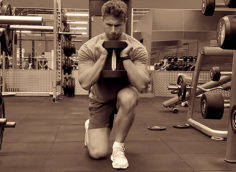Train Like an Athlete
You should be training like an athlete. Just about everyone should. If you're in a competitive strength sport (Olympic lifting, powerlifting, bodybuilding), things are different, but training like an athlete gives you one thing that's missing from many programs, and that's balance. And what better way to gauge your balance than with a series of strength and conditioning tests?
Balance doesn't necessarily mean giving equal time to every discipline. It means that in the overall program, you never sacrifice one area for another. I'm not talking a day or a week or even a training cycle. I'm talking big picture. Years. Even when your training cycle might be strength-based for a year, it doesn't mean you take the conditioning off the stove. It means you put it on a low setting and let it simmer for a while.
I can still kill some of the following tests. Others, not so much. That's not a bad thing; it only means that I need to balance my training. Look at it this way: Can you say anything negative about a man who can deadlift or squat 500 pounds, do 20 chin-ups, and run a 7-minute mile? No. The problem lies when that same person pulls 500 but struggles to complete a mile and do five chin-ups. That's where the imbalance becomes a problem.
The Training Standards
Understand that these tests and standards aren't for the competitive athlete. Second, some of these standards may be easy; others may be hard. Don't be upset with the standards if you fail to make the grade. Standards should exist regardless of the social consequences. They don't exist to make you sad, unhappy, or a victim.
And don't mistake physical tests as sports skill. Just because you can bench press more than the guy who plays in the NFL doesn't mean you can outplay him. It just means that if football were played on a bench press, with no ball, pads, hitting, blocking, tackling, running, catching, skill, talent, guts, determination and no play recognition or play calling, you'd make the big money, too. Lastly, these tests are for those of us who have many years of training experience. If you're new to training, they're not for you.
Many of these tests are largely rooted in football, the sport I played the most and have the most experience in training for. However, that doesn't mean these won't carry over to other disciplines. There are few sports that don't require a strong and powerful body and great conditioning. Some of these tests, though, are far from football testing, so there's a little something for everyone.

Lower Body Strength Tests
For this test, you get to test either the squat or the deadlift. Since some people are built to pull or squat, this leaves the athlete some room to work with. I also have no problem with an athlete choosing the trap bar deadlift. Now I know every powerlifting purist will scream, "Heresy!" in regards to the trap bar, but I think it's safe to say that powerlifters don't need to be making athlete decisions.
The test can be comprised of a one-rep max (1RM) derived by using a rep-max calculator for up to 10 reps. (No, the rep/max calculator doesn't give your projected max with any high level of accuracy; it's just a tool to help gauge performance.) Using just a 1RM as the sole way to test an athlete's strength is pointless.
And let's be honest, does anyone really care if an athlete does a 500-pound single or 425 for five reps? Strong is strong and the only people that fail to see this have yet to take a snap or get their picture in the media guide. To convert your rep max to a projected 1RM, use this simple formula:
Weight Lifted x Reps x .0333 + Weight Lifted = Projected Max
- 2.5 times bodyweight: Suburban All-Pro
- 2.0 times bodyweight: Starter
- Less than 2.0 times bodyweight: Just glad to be on the team, coach

Lower Body Power Tests
Lower body power is usually tested by the vertical jump, but we're all average dudes with average equipment so we'll use two tests that most people can do: standing long jump and box jump. If you don't have jump boxes, there are plenty of things for you to jump onto. I used my dad's pickup truck and the railings on my parent's backyard deck while in high school. You can choose to do one or both of these tests.
The standing long jump is done with your toes behind a line. Using both feet, jump out as far as you can and stick the landing. The distance is measured at the back of your heels. If you don't land with your feet even, measure the heel that's closest to the start of the jump. When doing this test, make sure to use your arms to help propel yourself.
The box jump is the most basic of all tests – you simply jump on a box. The big drawback of the box jump is that your hip mobility comes into play. Some people see this as a negative to the exercise/test, but hip mobility is part of the deal in just about every sport. Like with the standing long jump, be sure to use your arms.
Standing Long Jump
- 8.5 feet: Fat contract coming your way
- 8 feet: Making the grade
- Less than 8 feet: Time to buy some JumpSoles and believe they might help
Box Jump
- 40 inches: Talk of the neighborhood
- 38 inches: Star of your own home
- 36 inches: Your mom will be impressed

Upper Body Strength Tests
I wanted to include one press and one pulling movement for the upper body strength test. I didn't choose the bench press, however. Instead, I went with the press. (That's a strict, standing overhead barbell press. You should know that.)
While I don't necessarily believe that one lift or exercise is more "athletic" than another, I have a hard time justifying a test that requires you to lie down on a padded surface. Plus, there are a million bench press tests so it's high time the press gets a prom date.
The Press
Like the squat and deadlift, you can use a 1RM or a rep-max for the test. Once again, an athlete, the guy who uses the lifts as a means to perform his sport better, doesn't need to max out. He can, but it doesn't mean any more or less than a rep test. The only key to this test is to not turn it into a push press.
- 1 times bodyweight: Dating the head cheerleader
- 90% of bodyweight: Dating a cheerleader
- Less than 90% of bodyweight: Dating catcher on softball team
Pull-Up/Chin-Up Test
The second test is the pull-up/chin-up. Take whatever grip you want to use, even if it's a neutral grip. (However, I'm a big believer in using a wide variety of grips when training. This includes using ropes and towels.)
There are two tests you can attempt. Use the one you're good at. The first is a single, all-out set with your bodyweight. The second is a weighted pull-up/chin-up done with 10% of your bodyweight added. You can use a dip/chin belt or a weight vest. Do as many reps as you can in ten minutes. Do I need to add that the test is done with a strict motion?
- 20 reps of bodyweight/40 total reps with 10% added: Automatic A's in every class
- 15/30: Still have to show up and take tests
- 10/20: You have to take other people's tests for them

Conditioning Tests
These tests were done with a few things in mind. First, I wanted people to have a large variety to choose from. Not everyone has a Prowler. Likewise, not everyone can run a mile because they might be too heavy. Only two of these tests require special equipment and since you don't have to take every test, this gives everyone a chance to compete.
Second, I wanted to have longer tests AND shorter tests. Some people thrive on a mile run and others struggle, no matter how much they run. Do whatever test or tests you know you can do.
Mile Run
The mile run is simple; you simply run a mile for time. The second test is done on the AirDyne (specifically the AD6) for total miles in 20 minutes. This is perfect for heavier people as it's very easy on the knees, hips, and ankles.
Three Hundred Yard Shuttle
The next test is the 300-yard shuttle. This is done by doing ten consecutive 30-yard sprints for two total sets. After the first test, you rest five minutes and complete the second. Your time will be the average of the two runs. When running this test, make sure your turns are crisp and you stay in as straight a line as possible. If you round your corners, you waste time.
Prowler Push
The final test is a Prowler push done for ten 40-yard sprints with your bodyweight on the Prowler done for time. (Yes, the Prowler itself factors into the total weight.) We came up with the Prowler test while using the street outside my house. The surface you push on can vary greatly in resistance, so the Prowler test is horribly flawed, but it's still a worthy test. Besides, you can always make your own test and standards.
If your numbers fall into the following categories, you get an interview with ESPN:
- Mile: 7:00 and under
- AirDyne: 7.5 miles in 20 minutes
- 300 Shuttle: 60 seconds and under (average)
- Prowler: 15 minutes
If they fall into these categories, you get an interview with the school paper:
- Mile: 7:01 to 8:00
- AirDyne: 7 miles in 20 minutes
- 300-yard shuttle: 61-65 seconds (average)
- Prowler: 18 minutes
And, if your numbers fall into these categories, you work for the school paper:
- Mile: 8:01+
- Air Dyne: 6.5 miles in 20 minutes
- 300-yard shuttle: 65+ seconds (average)
- Prowler: 18+ minutes




